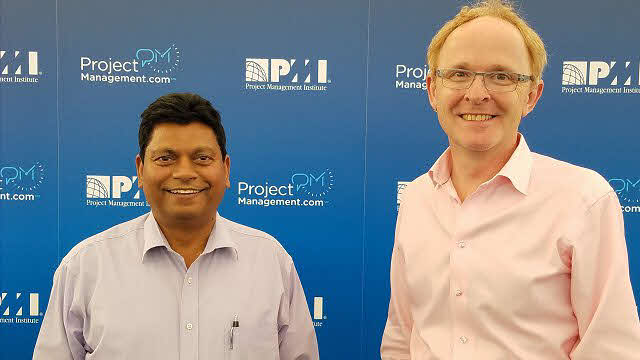Scrum project management might sound like a strange term, as there is no formal definition of the role of a project manager in Agile approaches. However, Scrum is often thought of as a way to deliver projects in an agile environment. Being able to effectively manage product development work using Scrum is a growing skill area for people in a variety of roles.
As organizations grow, they sometimes adopt a ‘Scrum of Scrums’ model which needs some oversight and coordination, however that is achieved in the business. There are lots of different ways to succeed in a Scrum environment, whether you have a formal project management role or not. For example, lean scrum project management is one of the possible ‘flavors’ of this agile approach that you may come across in your career.
In this Scrum project management guide, we’ll cover what you need to know about the Scrum project management framework. The selection of curated podcast episodes below provides an introduction to the world of Agile Scrum project management and the skills you need to successfully lead Agile teams regardless of your job title.
Article Contents
- Featured Podcast: The Project Manager's Role in a Scrum, Lean, and Agile World
- What is Scrum Methodology?
- Evolution of Scrum
- How Scrum is Used To Manage Projects
- Benefits of Scrum in Agile Project Management
- Roles and responsibilities of each member of the Scrum team
- Artifacts in Scrum
- Activities in Scrum
- Scrum Checklist
- How to Successfully Apply Scrum in Projects
- Ready to Get Started with Scrum?
- PM Podcast Episodes about Scrum Project Management
- Summary
Featured Podcast: The Project Manager's Role in a Scrum, Lean, and Agile World
Listen now to this featured podcast about Scrum project management and other agile methods.

What is Scrum Methodology?
Scrum is a framework and set of processes used to manage and control projects like product development. Scrum provides the tools to address complex problems while delivering incremental business value and a high quality product.
The Agile Alliance goes on to explain that Scrum is highly empirical. In other words, it enables teams to try new things, learn from that experience and adapt what they do to constantly evolve the product for the best result.
People sometimes ask: "What does Scrum stand for?" The answer is: nothing! Scrum is not an acronym. The name comes from the game of rugby where the team works as one to win, with multiple hand-offs between players.
Evolution of Scrum
So how did Scrum come about?
In terms of the history of project management, Scrum is only a baby, although it has roots in productivity and continuous learning -- concepts that have been around for a long time. Here's a brief timeline of how this agile way of working has evolved into what we recognize today.
1986
The New New Product Development Game
1990's
The Framework Evolves
1995
The OOPSLA Workshop
2001
The Agile Manifesto
2002
Scrum Alliance Founded
2009
Scrum.org Founded
2017
The Latest Scrum Guide
How Scrum is Used To Manage Projects
A common question is: ‘Is Scrum a project management methodology’ and the answer is: No. You can deliver projects using Scrum but it’s a framework, not a methodology.
Technically, there is no role for the project manager in a Scrum team. The work of the project manager is split between the members of the Scrum team. The responsibilities you would normally expect to be done by a project manager are, in the main, shared between the Product Owner and the Scrum Master. (By the end of this article you will understand what those roles mean and the part the individuals play on the project.)
However, as Scrum is a way to get work done using Agile principles, it is used for project management. Every sprint is a step on the journey to completing the end product. If you have a clear goal in mind, you can use sprints to get there. You’ve delivered your project by using an agile framework and iterative development instead of a predictive approach.
Benefits of Scrum in Agile Project Management
There are lots of Scrum project management benefits. Here are some of the most common that we see across the majority of teams adopting a Scrum project management process.
-
Increased productivity
-
Improved product quality
-
Faster delivery times
-
Improved team morale and stakeholder satisfaction
-
Improved collaboration and communication between the team.
-
Increased productivityPart of the role of the Scrum Master is to ensure that the team is operating productively, following the framework and continuously improving. The Scrum Master is a team coach who facilitates the process, asking questions and helping the team evolve their own set of best practices for the project. A commitment to productivity, evidenced by working software, is one of the values documented in the Agile Manifesto. It's something you will see in many agile project management environments which are known for being efficient teams.
-
Improved product qualityQuality is inherent in Scrum. Each sprint delivers a working feature, so the team has to focus each time on making sure they deliver something of value. That doesn't always mean a sprint results in something the customer can see or touch. For example, it could be a backend security feature or part of the product that provides the foundation for the section the customer does see. Because development is incremental, there is a strong focus on getting things right. Quality testing is an important part of software development frameworks, and Scrum is no different.
-
Faster delivery times
You've probably realized by now that one of the things that makes Scrum different from predictive approaches to delivering projects is that there is no 'big bang' launch. Scrum teams deliver incremental improvements, sprint after sprint. The end result is that customers see more deliveries sooner. They can start getting benefit from the parts of the product that have been delivered.
Fast delivery times are helpful for the client, but also for the team doing the work. If you work in an agency environment, for example, you can show progress through a working product, which helps the customer build confidence in your ability and your processes.
-
Improved team satisfaction
Project teams don't always have a way to formally measure team morale and customer satisfaction, but you can be sure that project managers and Scrum Masters know how the team and client is feeling at any moment. Another benefit of using Scrum is that teams have high morale. In our experience, this is usually because they have high autonomy, are trusted by the customer, work closely with the end users and know that they are delivering something that clearly meets the requirements. In other words, they are doing useful work for people who want it. That's a huge morale boost for any team!
We also see customers reporting a high level of satisfaction in both the process (because it is so customer-focused, inclusive and flexible) and the result. They see the incremental deliveries regularly during sprint reviews so have the opportunity to provide detailed feedback. The Product Owner shapes the direction of the project and ensures the end result is exactly what the business needs.
-
Improved collaborationThis is a huge benefit, and often the reason why teams shift to using agile methods. Because Scrum is founded on having a self-contained, multi-functional team, collaboration is easier: it simply becomes part of the job. Scrum ceremonies like the daily standup also help with communication and collaboration, because they provide moments for the team to come together, build relationships and check in with each other.
Roles and responsibilities of each member of the Scrum team
-
Product Owner
-
Development Team
-
Scrum Master.
Product Owner
-
Defines the roadmap for the solution
-
Determines what the end result will look like
-
Uses stakeholder feedback to ensure that the product features match the user requirements
-
Responsible for maintaining the product backlog
Development Team
-
Decides how to deliver the work specified by the Product Owner
-
Ensures transparency through communicating at the daily scrum meeting
-
Makes decisions to resolve issues and solve problems
Scrum Master
-
Ensures everything works effectively
-
Removes roadblocks for the team
-
Facilitates the process including the daily standup
-
Helps the Product Owner order the work, manage the backlog and plan
-
Coaches the team on Scrum values and supports transparency and empiricism in the team
Artifacts in Scrum
-
Product backlog
-
Sprint backlog
-
Product increment
-
Burndown chart
-
Product BacklogThe product backlog contains all the features to be built or items to work on. These are called user stories, because the focus on what the user wants to get out of the product and how they will use it. The backlog is a work in progress and is constantly evolving. It helps the team identify what is the next most important item to work on. The backlog is owned by the Product Owner who selects, orders and prioritizes the work of the team based on what is in the backlog.
-
Sprint BacklogThe sprint backlog describes what work will be done during this sprint. It also contains details of how the work will be done – it’s the plan for delivery. The sprint backlog should be highly visible during the sprint and constantly updated in real-time as work progresses.
-
Product IncrementThe product increment is a way of describing the outcome or benefit of the work; how the team will know if they’ve got to ‘Done’. In a software development environment, it would be defined as the increase or addition of new features.
-
Burndown chartA burndown chart shows the amount of work still to be completed on a sprint. It's a visual representation of what the team has achieved and what is outstanding. It promotes transparency across the team and gives you an at-a-glance view about whether the team is on track to complete the specified work for the sprint.
Activities in Scrum
In a Scrum project management environment, there are several events (also known as meetings or ceremonies) that help keep the team focused and making progress. These include:
-
Sprint
-
Sprint planning
-
Daily Scrum meeting
-
Sprint reviews
-
Sprint retrospectives
-
SprintA sprint is a defined period of time during which the team works on completing specific tasks. A sprint can be any length of time that suits the cadence of your organization, but it is most common to have sprints that last between 2-4 weeks. The work completed during the sprint is determined by the sprint planning meeting.
-
Sprint planningThe Sprint planning meeting is where the team decides what to deliver during the Sprint and how to do the work. The Product Owner sets the direction and helps the team identify the priorities.
-
Daily Scrum meeting (standup)The daily Scrum meeting is a short, focused meeting to improve communication. You might have heard it called a standup. People really do stand up in the meeting because it helps the team remember to keep the discussion short. It also physically makes the meeting different from other project meetings. And yes, you can have standups with a virtual team. The purpose of the daily standup is to help the team identify any roadblocks and how to get around them. The team shares information and makes quick decisions so the project can continue.
-
Sprint reviewsThe Sprint review takes place once the work of the Sprint is complete. During the meeting, the team reviews what was delivered. The outcome of the Sprint review may also be changes to the Product Backlog if required.
-
Sprint retrospectivesThe Sprint retrospective takes place at the end of the Sprint. During the meeting, the team reviews what was done during the Sprint with a view to making continuous improvements to future work based on the learning.
The Scrum approach to project management gives the team complete flexibility to adapt the processes to what works best for them. You might find that working as a Scrum project manager looks and feels different in different teams. With a focus on quality, it’s important that the method is adjusted to get the best results for that team, at that time, on that project.
Scrum Checklist
A Scrum checklist can be useful to help you get started with making sure you are following the basic principles of the framework. Here is a simple checklist that covers the high-level goals of Scrum so you can review whether you are meeting the needs of the organization and following the process.
-
Do you have a Product Owner?
-
Are you prioritizing what the business feels is most important?
-
Does everyone know the goal of the sprint and what 'done' looks like?
-
Does the whole team participate in regular sprint planning meetings?
-
Do you have a visible sprint backlog, updated regularly?
-
Do you have a daily Scrum meeting?
-
Is every sprint timeboxed to 4 weeks or less?
-
Does every sprint end with a working feature delivered and demonstrated to the customer?
-
Do you have retrospectives after every sprint?
If you need a more detailed Scrum checklist, we recommend Henrik Kniberg’s checklist. It is comprehensive and commonly used, but there are others you can find online as well, so look around for something that suits your team.
You can use a Scrum Checklist during the retrospective to review the work of the team and ensure you are hitting the main important aspects of the framework and focusing on the things that matter.
However, checklists should only be used as a guide. They are a way of learning from other teams and sharing good practice, but always remember to apply your own situation to any checklist and take from it what might be useful to your own environment.
How to Successfully Apply Scrum in Projects
-
Step 1: Compile the backlog
-
Step 2: Hold a planning meeting
-
Step 3: Compile the sprint backlog
Step 1: Compile the Product Backlog
Step 2: Hold a Planning Meeting
Step 3: Compile the Sprint Backlog
As we've seen, Scrum is a framework. Instead of having to follow a process or series of steps because that is what the project schedule mandates, you can flex to meet the most pressing priorities. This might mean bringing forward requirements that are urgent, building quality into the delivery and making sure progress is being taken in the direction the stakeholders expect. All these things can be achieved with low levels of friction and conflict because the approach allows for flexibility.
As a team, you can quickly inspect the output to ensure it meets quality criteria, and make changes if you feel the product is falling short. You get fast feedback on product features, and customers are closely involved in the work so you know you are delivering something that they will benefit from.
Ready to Get Started with Scrum?
Get started with Scrum project management by bringing the team together and adopting Scrum approaches to doing the work. You don't need any special tools to get going because much of the change in working in an agile way is a shift in culture and mindset.
With the support of a Scrum Master, and a focus on project delivery, you can adopt this tried-and-tested way of working. Check out the podcasts and resources on this page as a starting point, or to delve into advanced agile topics.
I believe that most people who become Agile certified and study the methodologies understand that Agile is the best approach for knowledge-based work –- work that’s complex, fast-moving, and volatile. This is the kind of work that really dominates our age now: the information age. I think Agile offers superior project management approaches to do that type of work.

PM Podcast Episodes about Scrum Project Management
The Agile Manifesto for Project Managers

The Keys to Building a High-Performing Scrum Team

Agile Project Portfolio Management

The Warning Signs That Tell You Agile Isn't Working

Summary
Scrum project management is a reliable and exciting way to work. You’ll see constant deliveries and benefit from the visual approach to managing projects that Scrum teams use: whiteboards and sticky notes (physical or digital) will soon become the way you share status and manage progress!
The great thing about a Scrum project team is that all the information required to do the work is easily available. There’s transparency across the team, and because delivery is a collaborative effort, everyone knows what is going on. That makes it easy for the team to adapt to the current situation, whatever that might be.
Scrum is one of several Agile methodologies that help you work closely with the customer to make rapid improvements. You’ll know your Scrum projects are having a real business impact because you’ll see the proof in the results and in stakeholder satisfaction.
Project Management for Beginners and Experts
Company
Customer Service
PMP PDUs
Exam Prep Training
PM PrepCast, Agile PrepCast, PM Exam Simulator, PDU Podcast, PM Podcast are marks of OSP International LLC. PMI, PMBOK, PMP, PgMP, PfMP, CAPM, PMI-SP, PMI-RMP, PMI-ACP, and PMI-PBA are registered marks of the Project Management Institute, Inc.
Copyright © 2023 OSP International LLC. All Rights Reserved. Our Privacy Notice: http://www.osp-international.com/privacynotice